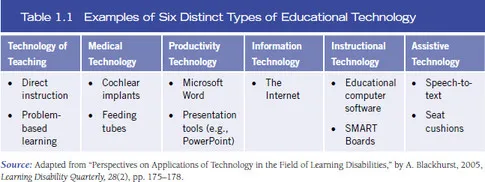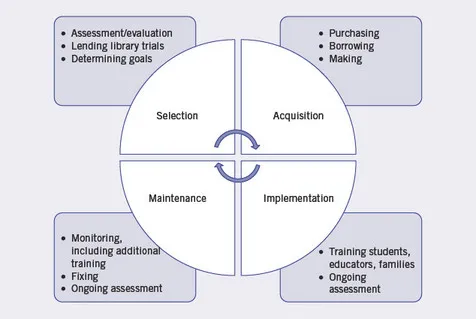Chapter 1 presents background information to help the reader understand assistive technology for students with disabilities, including understanding the categorization of assistive technology and aspects of legislation. Chapter 1 sets the stage for the remaining chapters that will present assistive technology aligned with issues of disability or age. Chapter 1 concludes by discussing Universal Design for Learning (UDL), including the relationship between UDL and assistive technology.
Technology—widely defined as tools—has been present in society since the beginning. Technological innovations, ranging from stone tools to crayons and to the Internet and iPads, helped shape society and continue to do so (Mishra & the Deep-Play Research Group, 2012). Recent research suggests many young individuals as well as adults are increasingly using more sophisticated (i.e., modern, digital) technology in their everyday lives, such as cell phones, computers, and MP3 players (Banks 2008; Madden, Lenhart, Duggan, Cortesi, & Gasser, 2013; Rideout, Foehr, & Roberts, 2010). Aside from daily life, technological innovations also helped to shape education and teaching and learning. In terms of digital and modern technology, such as computers and the Internet, access in schools dramatically increased over the last two decades, with an average student to instructional computer ratio of 3:1 in all public schools and 98% of all public schools having Internet access (National Center for Education Statistics, 2013).
Technology in education is often referred to as educational technology, “the application of technology to teaching and learning” (Edyburn, 2013, p. 9). Technology in education can be broadly defined, including today’s modern conceptualizations of technology (e.g., computers, the Internet, iPads), as well as some of the original tools used in schools (e.g., the slate and chalk) (Blackhurst, 2005a; Mishra & Koehler, 2009). The broad category of educational technology can be subdivided into different types: (a) technology of teaching (i.e., instructional approaches); (b) medical technology (i.e., devices involving one’s health); (c) productivity technology (i.e., tools for creating products); (d) information technology (i.e., tools that provide access to information); (e) instructional technology (i.e., tools that support learning); and (f) assistive technology (i.e., devices to support the independence and access of students with disabilities) (Blackhurst, 2005a, 2005b) (see Table 1.1).
Perspective 1.1
Technology Mindset
Before we get into Chapter 1, where we define and describe assistive technology, let’s first take a step back and think about what technology we use throughout a typical day. Please consider responding to each of the prompts individually and then sharing with a small group or in a large-group discussion. Adapted from http://jan.ucc.nau.edu/clb232/mod1/topic1B_have_not505.htm
- Consider and list the technology you use consistently in your daily life.
- Select your favorite technology from your list. Generate the steps needed for you to use this device or tool.
- Next, consider what capabilities one needs to use this device, such as physical, sensory, cognitive.
- Now consider if you had a disability, what struggles or difficulties might you face in trying to use your selected technology. Think about the range of disabilities covered under IDEA (e.g., visual impairments, learning disabilities, intellectual disability, hearing impairment, emotional-behavior disorders).
- What could help you address the struggles or challenges you identified in the previous question?
Assistive Technology
Assistive technology is essentially technology to support individuals with disabilities. However, while assistive technology is typically considered devices and tools, it actually refers to devices as well as services to assist in the selection, acquisition, and maintenance of those devices. An assistive technology device, as defined by the Technology-Related Assistance for Individuals with Disabilities Act of 1988—called the Tech Act—(Pub. L. 100-407), is “any item, piece of equipment, or product system, whether acquired commercially, modified, or customized, that is used to increase, maintain, or improve functional capabilities of individuals with disabilities” (29 U.S.C. § 2202[2]). An assistive technology service refers to “any service that directly assists an individual in the selection, acquisition, or use of an assistive technology device” (Pub. L. 100-407). Specifically, more in-depth, the definition of assistive technology service addresses the following:
- The evaluation of the needs of a child with a disability, including a functional evaluation of the child in the child’s customary environment;
- Purchasing, leasing, or otherwise providing for the acquisition of assistive technology devices by children with disabilities;
- Selecting, designing, fitting, customizing, adapting, applying, maintaining, repairing, or replacing assistive technology devices;
- Coordinating and using other therapies, interventions, or services with assistive technology devices, such as those associated with existing education and rehabilitation plans and programs;
- Training or technical assistance for a child with a disability or, if appropriate, that child’s family; and
- Training or technical assistance for professionals (including individuals providing education or rehabilitation services), employers, or other individuals who provide services to, employ, or are otherwise substantially involved in the major life functions of that child (Individuals with Disabilities Education Improvement Act, 2004, 20 U.S.C. 1401(2) § 300.6; U.S. Department of Education, n.d.).
Table 1.1 Source: Adapted from “Perspectives on Applications of Technology in the Field of Learning Disabilities,” by A. Blackhurst, 2005, Learning Disability Quarterly, 28(2), pp. 175–178.
Assistive Technology Services
Assistive technology services are multifaceted but generally involve the selection, acquisition, implementation, and maintenance of assistive technology devices (see Figure 1.1). While assistive technology services may be provided by an assistive technology specialist, these specially trained related service providers are not available in every local educational agency (LEA). When LEAs do not have access to an assistive technology specialist, special education teachers, speech-language pathologists, occupational therapists, and/or instructional technologists may be responsible for providing assistive technology services (Edyburn, 2004; Marino, Marino, & Shaw, 2006).
Quality Indicators for Assistive Technology Services.
As noted, assistive technology services are multifaceted. To help support educators’ delivery of high-quality assistive technology services, the Quality Indicators for Assistive Technology Services (QIAT) were developed (see new website: http://www.qiat.org/index.html (Zabala et al., 2000; Zabala & Carl, 2005). QIAT focuses on assistive technology service development, delivery, and evaluation for students as well as for family members and school personnel supporting the student. To address a shortage of attention on assistive technology services, the QIAT Consortium was founded, which developed the quality indictors (Zabala et al., 2000). QIAT exists for (a) consideration of a student’s needs for assistive technology, (b) assessment for assistive technology, (c) documentation of assistive technology devices and services in the IEP, (d) assistive technology implementation, (e) effectiveness evaluation of assistive technology devices and services, (f) transition relative to assistive technology, (g) assistive technology professional development and training, and (h) administrator support and leadership for assistive technology.
Figure 1.1 A Visual Depiction of Assistive Technology Services Provided by an Assistive Technology Specialist or Other Individualized Education Program (IEP) Team Member
Source: E. Bouck. Adapted from Special Education in Contemporary Society: An Introduction to Exceptionality (5th ed.) by R. M. Gargiulo, 2015. Copyright 2015 by SAGE Publications.
The QIAT can be very useful for IEP teams as well as other educators involved with assistive technology decision-making and for implementation and monitoring. (Room precludes the reproduction of all the indicators in this textbook.) At the QIAT website, downloadable Microsoft Word and PDF documents exist for each of the eight areas (see http://www.qiat.org/indicators.html). In addition, QIAT matrices are available for self-evaluation of the application of QIAT in schools (QIAT Consortium, 2012). The matrices allow teams to assess themselves on the QIAT, ranging from unacceptable to promising practices for each indicator for each of the eight areas.
Perspective 1.2
Views of Technology
To what technology does the following quote refer to?
“Remarkable new technology is introduced into the school system and experts predict education will be revolutionized. The technology will, as never before, allow the widespread dissemination of new concepts and ideas that stimulate young minds and free the teacher for more creative pursuits. Yet, the magic fails to materialize, and within a few years articles appear in the popular press asserting that the failure obviously arises from the teachers not being skilled enough in the new technology.”
Case Study 1.1
Jordan is an assistive technology consultant for his county’s special education cooperative (i.e., the three school districts in the county where he works collaborate around special education services, including the location of programs and related service providers). While Jordan is not an assistive technology specialist, he does many of the same tasks. For example, Jordan works with students and teachers in grades preK–12 with mild through severe disabilities and needs. He helps to evaluate and write the assessment reports for students. He also works with the state lending library to obtain device trials and then helps to implement those devices as well as maintain them once they are selected for an individual student. Jordan also attends IEP meetings for students who need or may need assistive technology services. Finally, Jordan sees his role as a resource for direct service providers, such as teachers. He not only provides formal and informal training (i.e., creates videos on how to use different technology that are housed on a website educators have access to), but he will meet with teachers about issues relative to assistive technology.
Assistive Technology Device Categorization
Given the broad definition of assistive technology devices that appears in federal legislation (i.e., “any item, piece of equipment, or product system”), it is helpful to view assistive technology in different categorizations. Two common ways assistive technology is categorized are by level of technology and then purpose of technology. In terms of level of technology, one can categorize assistive technology devices as no tech, low tech, medium or mid tech, and high tech (Blackhurst, 1997; Edyburn, 2005; Johnson, Beard, & Carpenter, 2007; Vanderheiden, 1984) (see Table 1.2 for examples of assistive technology devices across the level of technology categorization). Of note, there is not agreement on the number of categories (e.g., two, three, four), nor is there universal acceptance on particular devices being strictly in one category versus another. For this book, we will discuss assistive technology as occurring within four categories: no tech, low tech, mid tech, and high tech.
No-tech is what it intuitively sounds like—no-technology assistive technology. No-tech assistive technology often can involve the implementation of a teaching strategy, such as mnemonics (e.g., HOMES for remembering the Great Lakes—Huron, Ontario, Michigan, Erie, and Superior) (Behrmann & Jerome, 2002; Blackhurst, 1997). Others also consider no-tech assistive techn...



